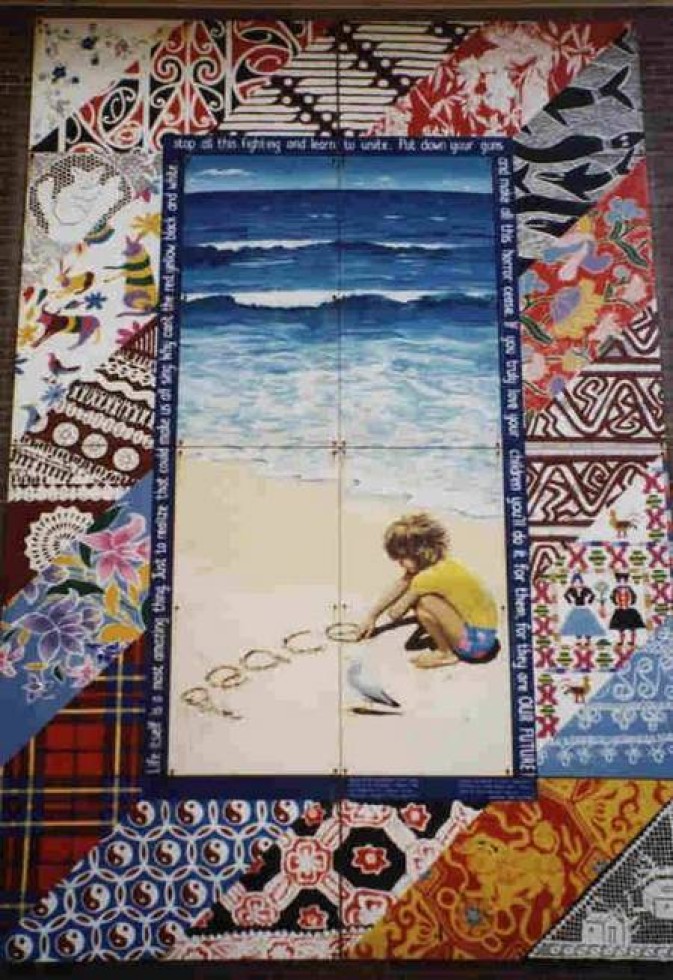Greek presence in Waverley Municipality (Bondi Junction, Bondi Beach areas) Sydney, Australia
Multi-cultural Mural at Bondi Beach Public School.
Stories From Across the Divide: Waverley’s Migration Heritage
Frm, given during the 2002 Heritage Festival at Waverley Library
by, Elida Meadows, in 2002.
[The Greek segment...]
Greek migration to Australia dates back to 1829 but the vast majority of Greeks came after World war II between 1945 and 1982. The first significant stream of Greek migration began in the 1850s, attracted to the discovery of gold in New South Wales and Victoria.
From the 1870s onwards, the establishment of chain-migration patterns resulted in the settlement of relatively large groups from the islands of Kythera, Ithaca and Kastellorizo. Most immigrants from Kythera went to New South Wales, settling in Sydney and some of the smaller towns. In 1940 there were more than 200 Kytherans in New South Wales, which, at the time, represented a quarter of all Greeks in Australia.
As early as the late 1910s there was a slight Greek presence in Waverley. B. T. Dowd, the author of Waverley's Centenary History in 1959, claims that Greek gypsies were camped at Bondi around 1901. However, most Greeks arrived during the post-war migration period. Of these, a significant proportion went into the food business. The catering trades were attractive because of a ‘traditional peasant desire’ for independence and security, though of equal importance was the possibility of employing kinsmen and compatriots. Such trades were also relatively free from government regulation and trade union interference, an important feature for Greek-Australians who were systematically excluded from unionised labour.
It was the 30-year old Greek cook of the Astra Hotel – Jimmy Koussis – who rescued a woman and her daughter from drowning in 1948.
Coffee-houses were established in the early years of Greek-Australian settlement to provide a social setting where people gathered to discuss political, religious, community, and sporting issues, to promote ethnic ties, and sometimes to gamble. Many coffee-houses provided services such as the sale of Greek newspapers and magazines, advertising community events, and they also functioned as labour exchanges.
Over time, there have been many Greek-owned milk bars and cafes in the Waverley area, some of them quite famous such as Bates at Bondi, but there was also Theo's at Charing Cross, Paul's at Bondi Junction and many more. Bates’ Milkbar closed last year after 50 years of operation on the corner of Curlewis Street and Campbell Parade. The owners, Nick and George left their Greek homeland in 1948 as 18 and 16 year olds. They became the proud owners of what was to become arguably Bondi’s most famous milkbar in 1951. George told a local paper that people had come from near and far to say goodbye. They’ve come from Narooma on the far south coast, Wollongong and even Broadbeach he said.
Just as fruit shops are associated with Italians, fish shops are associated with Greeks. The ‘pioneer’ of the Greek fish shop in Australia was Athanaios Kominos, who began trading in rented premises at 36 Oxford Street with his friend Theodore some time in 1878 (not long after his arrival in 1873).
In the early years of the twentieth century Greek fish shops were located in downtown Sydney along George, King and Pitt Streets, and also to the east and south-east of Hyde Park down William and Oxford Streets. Fish shops and other catering concerns were typically staffed by Greek cooks, kitchen hands, waiters, oyster openers and general assistants who lived close to their employment.
As previously mentioned, Greek fish-shops owned by people with names like Saradopolous and Karipas - began to appear along Oxford Street and Bondi Road in the Waverley area from the early decades of the twentieth century. Since then, as with all ethnic groups, Greeks have moved on and into all walks of life.
In the words of one well-known Greek journalist who once lived at Bondi - George Donikian – talking about our local area, there is a multicultural mix that is not only working, but is succeeding.
Multiculturalism is not just a word here. It is a way of life. And of course there are countless stories and many more cultures than we have been able to represent today who have made an impact on the history of Waverley......
Full text, at,
http://www.waverley.nsw.gov.au/library/about/waverley's_migration_heritage.htm
